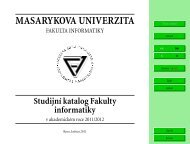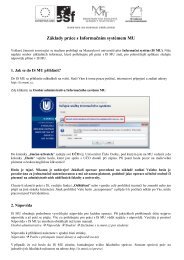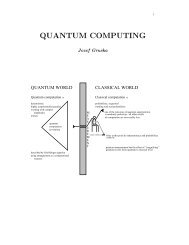Semantic Pre-processing of Anaphoric References
Semantic Pre-processing of Anaphoric References
Semantic Pre-processing of Anaphoric References
Create successful ePaper yourself
Turn your PDF publications into a flip-book with our unique Google optimized e-Paper software.
<strong>Semantic</strong> <strong>Pre</strong>-<strong>processing</strong> <strong>of</strong> <strong>Anaphoric</strong> <strong>References</strong> 47<br />
3. Type-Theoretical checking:<br />
λwλt [ 0 Look_for 0 wt<br />
Adam 0 Parking ]<br />
(oι(oι) τω )<br />
}<br />
ι<br />
{{<br />
(oι) τω<br />
}<br />
o<br />
o τω<br />
The role <strong>of</strong> Trivialisation and empirical parameters w → ω, t → τ in the<br />
communication between agents can be elucidated as follows. Each agent has<br />
to be equipped with a basic ontology, namely the set <strong>of</strong> primitive concepts<br />
(Trivialised objects) she is informed about. Thus the upper index ‘ 0 ’ serves as a<br />
marker <strong>of</strong> the primitive concept that the agents should have in their ontology.<br />
If they do not, they have to learn them by asking the others. The lower index<br />
‘ wt ’ can be understood as an instruction to execute an empirical inquiry (search)<br />
in order to obtain the actual current value <strong>of</strong> an intension, for instance by<br />
searching agent’s database or by asking the other agents, or even by means<br />
<strong>of</strong> agent’s sense perception.<br />
3 Anaphora and Meaning<br />
The problem <strong>of</strong> an anaphoric reference to a previously used expression is<br />
a well-known hard nut <strong>of</strong> linguistic analysis, because the antecedent <strong>of</strong> the<br />
anaphoric reference is <strong>of</strong>ten not unambiguously determined. Thus it is <strong>of</strong>ten<br />
said that anaphora constitutes a pragmatic problem rather than a problem<br />
<strong>of</strong> logical semantics. We agree that logical analysis cannot disambiguate any<br />
sentence, because it presupposes understanding and full linguistic competence.<br />
Yet our method <strong>of</strong> logical analysis can contribute to solving the problem <strong>of</strong><br />
disambiguation in at least two respects; (a) a type-theoretical analysis <strong>of</strong>ten<br />
unambiguously determines which <strong>of</strong> the possible meanings <strong>of</strong> a homonymous<br />
expression is used in a sentence, and (b) if there are two or more possible<br />
readings <strong>of</strong> a sentence, the logical analysis should make all <strong>of</strong> them explicit.<br />
This <strong>of</strong>ten concerns the distinction between de dicto and de re readings.<br />
In this section we propose a method <strong>of</strong> logically analysing sentences with<br />
anaphoric references. The method consists in substituting an appropriate<br />
construction <strong>of</strong> the object to which the anaphora refers for the anaphoric<br />
variable. In other words, we perform a semantic pre-<strong>processing</strong> <strong>of</strong> the embedded<br />
anaphoric clause based on the meaning <strong>of</strong> the respective antecedent. In this<br />
sense anaphora is a semantic problem.<br />
3.1 <strong>Semantic</strong> pre-<strong>processing</strong> <strong>of</strong> <strong>Anaphoric</strong> <strong>References</strong><br />
Our hyperintensional (procedural) semantics makes it possible to apply anticontextualist<br />
and compositional analysis to anaphoric sentences. The meaning<br />
<strong>of</strong> a sentence containing a clause with an anaphoric reference is the procedure<br />
which is a two-phase instruction that comes down to this:















